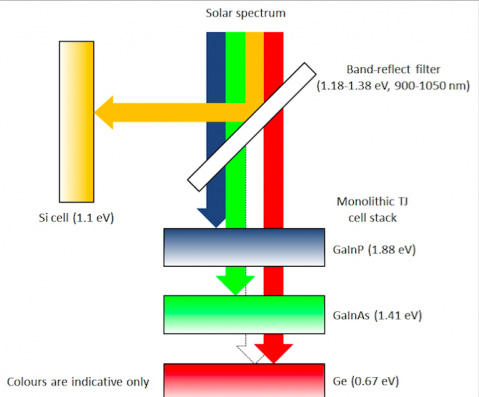- News
18 May 2016
UNSW boosts unconcentrated solar cell conversion efficiency to record 34.5%
A new solar cell configuration developed by the University of New South Wales (UNSW) has set a new solar energy conversion efficiency record of 34.5% for unfocused sunlight, nudging closer to the theoretical limits for such a device.
The record was set by Dr Mark Keevers and professor Martin Green (senior research fellow and director, respectively) at UNSW's Australian Centre for Advanced Photovoltaics (ACAP) using a 28cm2 four-junction mini-module – embedded in a prism – that extracts the maximum energy from sunlight. It does this by splitting the incoming rays into four bands, using a hybrid four-junction receiver to squeeze more electricity from each beam of sunlight.

Picture: Diagram of spectrum-splitting, four-junction mini-module developed at UNSW.
The record-setting UNSW mini-module combines a silicon cell on one face of a glass prism, with a triple-junction solar cell on the other.
The triple-junction cell targets discrete bands of the incoming sunlight, using a combination of three layers: indium gallium phosphide (InGaP), indium gallium arsenide (InGaAs), and germanium (Ge). As sunlight passes through each layer, energy is extracted by each junction at its most efficient wavelength, while the unused part of the light passes through to the next layer, and so on.
Some of the infrared band of incoming sunlight, unused by the triple-junction cell, is filtered out and bounced onto the silicon cell, extracting almost all of the energy from each beam of sunlight hitting the mini-module.
The new result, confirmed by the US National Renewable Energy Laboratory (NREL), is almost 44% better than the previous record cell – made by Alta Devices of the USA, which reached 24% efficiency, but over a larger surface area of 800cm2.
"This encouraging result shows that there are still advances to come in photovoltaics research to make solar cells even more efficient," says Keevers. "Extracting more energy from every beam of sunlight is critical to reducing the cost of electricity generated by solar cells as it lowers the investment needed, and delivering payback faster."
The result was obtained by the same UNSW team that set a record in 2014, achieving conversion efficiency of over 40% by using mirrors to concentrate the light in CPV (concentrator photovoltaics), and then similarly splitting out various wavelengths. However, the new result was achieved using unconcentrated sunlight.
"This level of efficiency had not been expected for many years," remarks Green. "A recent study by Germany's Agora Energiewende think-tank set an aggressive target of 35% efficiency by 2050 for a module that uses unconcentrated sunlight, such as the standard ones on family homes," he adds. "So, things are moving faster in solar cell efficiency than many experts expected."
Australia's research in photovoltaics has already generated flow-on benefits of more than $8bn to the country, Green says. Gains in efficiency alone, made possible by UNSW's PERC (passivated emitter rear-contact) cells, are forecast to save $750m in domestic electricity generation in the next decade. PERC cells were invented at UNSW and are now becoming the commercial standard globally, it is claimed.
The 34.5% result with the 28cm2 mini-module is already a world record, but scaling it up to a larger 800cm2 – thereby leaping beyond Alta Devices' 24% – is within reach. "There will be some marginal loss from interconnection in the scale-up, but we are so far ahead that it's entirely feasible," Keevers says. The theoretical limit for such a four-junction device is thought to be 53%, which puts the UNSW result two-thirds of the way there.
Multi-junction solar cells of this type are unlikely to find their way onto the rooftops of homes and offices soon, as they require more effort to manufacture and therefore cost more than standard crystalline silicon cells with a single junction. But the UNSW team is working on new techniques to reduce the manufacturing complexity, and create cheaper multi-junction cells.
However, the spectrum-splitting approach is perfect for solar towers, like those being developed by Australia's RayGen Resources, which use mirrors to concentrate sunlight which is then converted directly into electricity.
The research is supported by $1.4m grant funding from the Australian Renewable Energy Agency (ARENA), whose CEO Ivor Frischknecht said the achievement demonstrated the importance of supporting early-stage renewable energy technologies. The UNSW team is working with ARENA-supported RayGen to explore how the receiver could be rolled out at concentrated solar PV power plants.
"With the right support, Australia's world leading R&D is well placed to translate into efficiency wins for households through the ongoing roll out of rooftop solar and utility-scale solar projects such as those being advanced by ARENA through its current $100m large-scale solar round," says Frischknecht. "Over the longer term, these innovative technologies are also likely to take up less space on our rooftops and in our fields."
Other research partners working with UNSW include PV module manufacturer Trina Solar and NREL.
Australia's University of New South Wales and RayGen set record solar system efficiency of over 40%


